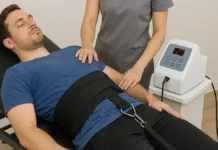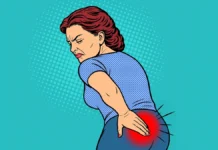Lower cross-body syndrome is a muscular imbalance brought on by an excessively sedentary lifestyle and poor posture that results in postural abnormalities and lower back discomfort.
Sitting for a long time or an accident may cause the hip flexor muscles to shorten, which tightens the lower back muscles. Hip flexor tightening eventually causes the gluteal and buttock muscles as well as the abdominal /abdominal muscles to weaken.

An elevated forward tilt of the pelvis and an excessive amount of lower back arch are the postural implications of this disorder. The repercussions of this unbalanced muscular pull extend beyond the lumbopelvic area of the hip, though. The hamstrings have to work harder when this happens, which may cause lower back and hamstring pain.
This can sometimes lead to a forward head posture and flat gluteus or even protruding glutes and a prominent abdomen.

This scheme is characterized by the following elements:
- Contraction of the quadratus lumborum, psoas, lumbar erector spinae, hamstrings, tensor fascia lata and possibly piriformis
- Lengthening and weakening of the gluteal and abdominal muscles.
These modifications cause the pelvis to tilt forward, flexing the hip joints, and causing lumbar lordosis and tension at L5-S1, resulting in discomfort. Another typical limitation that causes the pelvis to be maintained in an elevated position during walking may be seen in the sagittal plane. There will be lower back ache as a result.
The combined stresses described produce instability at the thoracolumbar junction, an unstable transition point.
Screening test
- First, stand with your back to the wall, your heels touching the wall. Try to flatten your lower back against the wall without letting your pelvis or shoulders leave the wall. Then, without moving your back, raise your arms above your head to touch the wall.
- The test will be positive if you cannot touch the wall with your arms while maintaining your posture.
- Sit on a table or other flat surface with your feet touching the floor. Lift your knee towards your chest and hold it there with your hands and slowly roll onto your back on the table, leaving your other foot on the floor.
- the test will be positive if you cannot lie down in this position without your suspended leg hanging in a horizontal position.
Therapeutic approach
A tense muscle must be stretched effectively. Stretching tense muscles improves the strength of inhibited antagonistic muscles, probably via Sherrington’s law of reciprocal innervation.
- Perform myofascial release and muscle trigger point massage:
- Gluteus maximus and tensor fascia lata
- Stretching the psoas and erector muscles of the lower back
- Strengthen abdominal and gluteus maximus muscles
- Rehabilitation of posture and use of the body. It is necessary to relearn the specific activation of each element within the Lower Pelvic Unit. This will establish the important fundamental patterns of intra-pevlic control and also integrate these patterns into the basic functional patterns of movement control initiated from the pelvis.
- Rehabilitation of patients with posterior pelvic cross syndrome
Psoas stretch

























